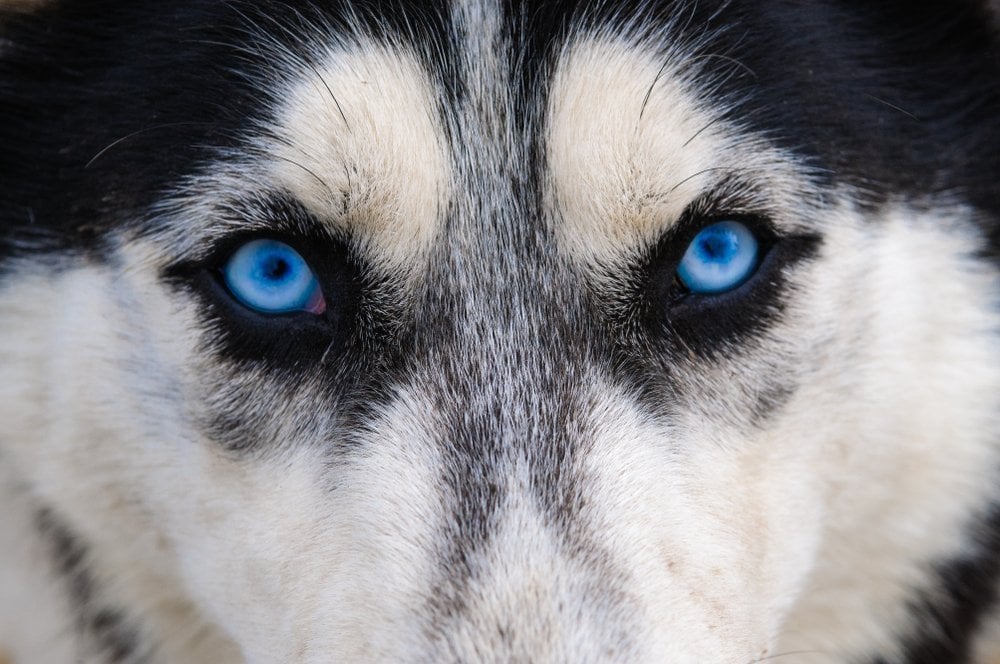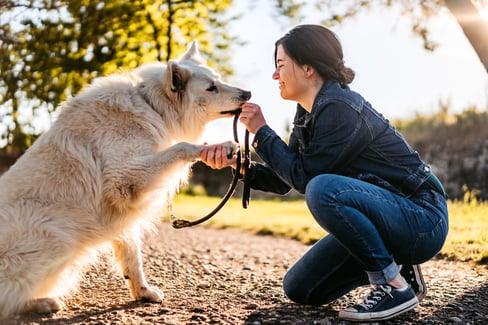Table of Contents
Have you ever considered how the ingredients are chosen by companies that formulate supplements for dogs? Domestic dogs (Canis familiaris) and their human counterparts have shared a prosperous and emotionally meaningful co-existence for around 4,000 years (1). Our shared history coincides at a time when human communities revolved around agriculture and tended to stay sedentary. In this time, opportunistic grey wolves (Canis lupus) found a reliable food source in the vegetal and animal food waste items from human settlements. Those wolves in closer proximity to human contact had a greater tendency to thrive, given the dietary and caloric stability – a key feature in the dog lineage.
Still, wolves remained genetically distinct until their adoption and domestication by humans, requiring many generations of selective breeding. Our tendency in choosing those animals that succeeded as security allies, hunting counterparts, retrievers, and herders – such as heelers and shepherds – arrived to the point that we called them companions.
So, what makes dogs, dogs? And how is that different from their wolf predecessors? Selective breeding guided by humans has shaped everything from size and shape to markings and coat texture, to behaviors such as loyalty and affection. In comparison to wolves, these traits are alleged to be driven by just four adaptive chromosomal locations (2). These changes have even improved dietary compatibility with humans that permitted the long-term viability of dogs.
Where wolves are apex predators that encounter seasonally fluctuating food availability, the modern dog gets two square meals a day, plus treats for good behavior. These two different feeding strategies result in some key insights to canine nutrition and supplements for dogs. Below, we’ll highlight what these insights mean for the modern canine diet.
Preliminary Food Processing: Teeth, Jaws and Salivary Glands
Preliminary food processing in dogs appears to be nearly identical, albeit on a smaller scale compared to their wolf predecessors. Like wolves, dogs have retained the same tools for mastication. This means they still have canine and incisor teeth that wolves use to hold prey and carnassial teeth for shearing food items (3), coupled with a fixed jaw for cutting and flat premolars for crushing bones. Not surprisingly, dogs still retain the same gustatory taste sensors receptive to amino acids and nucleotides. These Type D taste receptors are less responsive to fruity-sweet compounds and are better suited to positive feedback in seeking flesh or organ meat (4).
Interestingly, despite a reliance on an omnivorous human diet, domestic dogs never acquired salivary amylase through selective breeding (5). Salivary amylase is an enzyme that assists in breaking down starch into constituent sugars and was suspected as an acquired mutation that would enhance the viability of domestic dogs alongside humans.
Fluctuating food availability
Unlike dogs, wolves are at the mercy of seasonal periods of prey abundance and other periods of famine. For this reason, wolves have highly expandable stomachs and can ingest a meal weight of up to 22% of their body mass, preferentially choosing fats and nutrient-rich marrow and organs such as the liver (6). During periods of famine, wolves are well adapted at defending their body weight with relatively little weight loss and the ability to regain lost weight as quickly as 2 days (7). Despite greater food security, dogs have retained the ability to withstand periods of famine by efficiently using body fat reserves for energy (8). This helps spare protein and amino acids for metabolic functions (9), helping to retain muscle. Moreover, domestication did not affect the ability of dogs to be able to synthesize the essential nutrients taurine, arginine niacin and arachidonic acid, even during feeding dry-spells (10).
Gastrointestinal Digestion
In terms of food intake and processing, it appears that many of the features seen in wolves have been conserved still in dogs. This is also true for certain carnivorous features of the gastrointestinal tract including a more acidic stomach pH and a short intestinal tract typical for extracting nutrients from wild game (11).
While most aspects of the Canis GI tract remain intact, dogs have acquired a few adaptive enzymatic mutations that improve their ability to extract nutrients from plant matter, such as tubers, grains, vegetables and fruits. Though amylase (the starch cleaving enzyme) is not expressed in the salivary glands of the mouth, amylase expression is upregulated nearly 5-fold in the digestive tract of dogs (12). This improves a dog’s ability to use carbohydrates from vegetable like, tubers that would otherwise be locked-up in the form of starch. Meanwhile, dogs also exhibit a higher expression of an enzyme called, maltase-glucoamylase (MGAM). In a similar manner to amylase, MGAM processes a complex disaccharide sugar, maltose into a simple monosaccharide glucose. Maltose is a common sugar found in grains, a food staple of most human cultures. Remarkably still, dogs also have an enhanced ability to shuttle glucose from the gut and into the blood for improved availability as an energy substrate.
Where wolves typically rely on a protein-fat-carbohydrate ratio of 54:45:1%, dogs can thrive on a more lipid-dependent and carbohydrate-tolerant diet approximating 30:63:7% (13). While plant-matter is not likely to prevail as the primary nutrient source of dogs, it does point to the fact that dogs have adapted to a more omnivorous diet.
What does this mean for my dog?
For the feast drive shared by both species, the stomach remains highly expandable to accommodate abundances in food. From an evolutionary perspective, this makes sense given the uncertain nature of the food supply in the wild; if today brings abundance and involuntary fasting is on the horizon, a wolf’s (or dog’s) natural tendency is to gorge now.
Today’s dog owners should be mindful of the tendency to gorge. You will fail in trying to persuade your dog that under your supervision, their food supply is secure. But, given the opportunity, your dog is likely to wolf down any extra helpings which can lead to weight gain. This is particularly true for savory foods rich in proteins and fats given their retention of Type D taste receptors.
While many feed makers tout ‘ancestral’ diets showcasing B-roll footage of huskies running in the wild as if on the hunt for dinner, understand that your dog is not a wolf. The story of man’s best friend is a story of coevolution, where a dog’s diet became more compatible with that of humans. The modern dog has the enzymatic machinery to metabolize and thrive on a diet that incorporates vegetable matter. Added to that, vegetable and grain matter are typically crushed and pulverized before being combined with other ingredients. This helps compensate for the fact that dog’s lack molar teeth, typical in omnivores.
The diversity of food items available to dogs can help ensure a more stable and balanced diet of micronutrients such as vitamins and minerals. The rise in popularity amongst raw-feeding dog owners is a community of passionate, culinary chefs who prepare top-notch meals for their dogs. These chefs should be eager and willing to incorporate vegetable-matter into raw-meat regimen including tubers, vegetables and fruits. Additionally, dogs also possess the ability to assimilate nutrients from grains, something worth considering when choosing which plant matters are incorporated into their feeds.
No one could fault a pet owner for wanting what’s best for their dog, and that includes choosing a premium supplement for dogs. Though wolves are the most recent common ancestor of all domesticated dogs, it’s important to remember that dogs are not wolves. Wolves are not compliant to training or human bonding and as such belong in the wild, on the hunt for their next meal. In the meantime, we can take comfort in knowing that our dogs are adapted for a diet that loosely resembles our own.
Cited work:
1) Driscoll CA, Macdonald DW & O’Brien SJ (2009) From wild animals to domestic pets, an evolutionary view of domestication. Proc Natl Acad Sci USA 106, 9971–9978.
2) Boyko AR, Quignon P, Li L, et al. (2010) A simple genetic architecture underlies morphological variation in dogs. PLoS Biol 8, e1000451.
3) Biknevicius AR & Van Valkenburg B (1996) Design for killing: craniodental adaptations of predators. In Carnivore Behavior, Ecology, and Evolution, pp. 393–428 [JL Gittleman, editor]. Ithaca, NY: Cornell University Press.
4) Bradshaw JW (2006) The evolutionary basis for the feeding behavior of domestic dogs (Canis familiaris) and cats (Felis catus). J Nutr 136, S1927–S1931
5) NRC (2006) Nutrient Requirements of Dogs and Cats. Washington, DC: National Academies Press.
6) Biknevicius AR & Van Valkenburg B (1996) Design for killing: craniodental adaptations of predators. In Carnivore Behavior, Ecology, and Evolution, pp. 393–428 [JL Gittleman, editor]. Ithaca, NY: Cornell University Press.
7) Kreeger TJ, DelGiudice GD & Mech LD (1997) Effects of fasting and refeeding on body composition of captive gray wolves (Canis lupus). Can J Zool 75, 1549–1552.
8) de Bruijne JJ & van den Brom WE (1986) The effect of long-term fasting on ketone body metabolism in the dog. Comp Biochem Physiol B 83, 391–395.
9) Kreeger TJ (2003) The internal wolf: physiology, patho- logy, and pharmacology. In Wolves: Behavior, Ecology, and Conservation, pp. 192–217 [LD Mech and L Boitani, editors]. Chicago, IL: University of Chicago Press.
10) Morris JG (2002) Idiosyncratic nutrient requirements of cats appear to be diet-induced evolutionary adaptations. Nutr Res Rev 15, 153–168.
11) NRC (2006) Nutrient Requirements of Dogs and Cats. Washington, DC: National Academies Press.
12) Axelsson E, Ratnakumar A, Arendt ML, et al. (2013) The genomic signature of dog domestication reveals adaptation to a starch-rich diet. Nature 495, 360–364.
13) Hewson-Hughes AK, Hewson-Hughes VL, Colyer A, et al. (2013) Geometric analysis of macronutrient selection in breeds of the domestic dog, Canis lupus familiaris. Behav Ecol 24, 293–304.
*This article is adapted from the relevant information the review article: Dietary nutrient profiles of wild wolves: insights for optimal dog nutrition?, Bosch et al. 2013
Newsletter Signup
Subscribe to our newsletter to receive the latest news and exclusive offers.
.jpg?height=2000&name=Cliick_Integricare-DISPLAY-REVISEDV2%20(1).jpg)
Proactive & Therapeutic Joint Supplements
When given daily, Integricare joint supplements recover bone and joint injuries faster and help prevent mobility injuries from happening in the first place.











